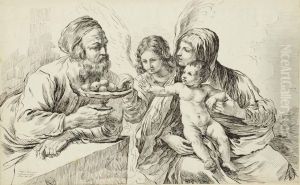Anne Claude Philippe De Caylus Paintings
Anne Claude Philippe de Caylus, commonly known as the Comte de Caylus, was a French antiquarian, engraver, and man of letters born on October 31, 1692, in Paris, France. His father, the Marquis de Caylus, was a distinguished soldier, and his mother, Marthe-Marguerite Le Valois de Villette de Mursay, was a niece of Madame de Maintenon, who was the second wife of King Louis XIV. This connection with the court would influence his later interests and engagements with the arts and antiquities.
Caylus developed a passion for the arts early in life, and after a brief military career, he dedicated himself to the study of antiquities and art. He was an early contributor to the development of archaeology as a scientific discipline and is often remembered for his efforts to classify artworks and artifacts. His travels throughout Europe and the Near East allowed him to amass a vast knowledge of ancient art and to collect many artifacts.
In addition to his work in archaeology, Caylus was also known as an engraver and a writer. He produced a significant number of engravings, which were highly regarded by his contemporaries. As a writer, he contributed to the understanding of ancient art and aesthetics with publications such as 'Recueil d'antiquités égyptiennes, étrusques, grecques et romaines' (Collection of Egyptian, Etruscan, Greek, and Roman Antiquities), which was a multi-volume work published between 1752 and 1767. This publication had a profound impact on the study of antiquities and was one of the foundations for modern archaeology.
Caylus was an active member of the Académie Royale de Peinture et de Sculpture and the Académie des Inscriptions et Belles-Lettres. He was a patron of artists and had friendships with prominent figures in the art world, including the famed engraver Charles-Nicolas Cochin and the painter François Boucher. His critical approach to the analysis of art, insistence on the importance of drawing from life, and advocacy for the study of classical sources were influential in the artistic community of his time.
The Comte de Caylus passed away on September 5, 1765, in Paris. He left behind a rich legacy as a collector, scholar, and an important figure in the development of art history and archaeology. His extensive work and collections contributed greatly to the preservation and understanding of ancient cultures and their artistic expressions.
